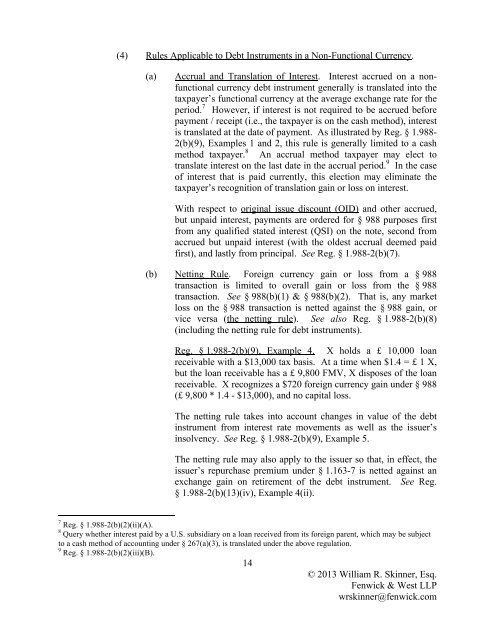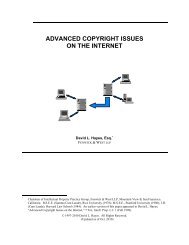International Tax Aspects of Foreign Currency Transactions
International Tax Aspects of Foreign Currency Transactions
International Tax Aspects of Foreign Currency Transactions
Create successful ePaper yourself
Turn your PDF publications into a flip-book with our unique Google optimized e-Paper software.
(4) Rules Applicable to Debt Instruments in a Non-Functional <strong>Currency</strong>.(a)Accrual and Translation <strong>of</strong> Interest. Interest accrued on a nonfunctionalcurrency debt instrument generally is translated into thetaxpayer’s functional currency at the average exchange rate for theperiod. 7 However, if interest is not required to be accrued beforepayment / receipt (i.e., the taxpayer is on the cash method), interestis translated at the date <strong>of</strong> payment. As illustrated by Reg. § 1.988-2(b)(9), Examples 1 and 2, this rule is generally limited to a cashmethod taxpayer. 8 An accrual method taxpayer may elect totranslate interest on the last date in the accrual period. 9 In the case<strong>of</strong> interest that is paid currently, this election may eliminate thetaxpayer’s recognition <strong>of</strong> translation gain or loss on interest.With respect to original issue discount (OID) and other accrued,but unpaid interest, payments are ordered for § 988 purposes firstfrom any qualified stated interest (QSI) on the note, second fromaccrued but unpaid interest (with the oldest accrual deemed paidfirst), and lastly from principal. See Reg. § 1.988-2(b)(7).(b) Netting Rule. <strong>Foreign</strong> currency gain or loss from a § 988transaction is limited to overall gain or loss from the § 988transaction. See § 988(b)(1) & § 988(b)(2). That is, any marketloss on the § 988 transaction is netted against the § 988 gain, orvice versa (the netting rule). See also Reg. § 1.988-2(b)(8)(including the netting rule for debt instruments).Reg. § 1.988-2(b)(9), Example 4. X holds a £ 10,000 loanreceivable with a $13,000 tax basis. At a time when $1.4 = £ 1 X,but the loan receivable has a £ 9,800 FMV, X disposes <strong>of</strong> the loanreceivable. X recognizes a $720 foreign currency gain under § 988(£ 9,800 * 1.4 - $13,000), and no capital loss.The netting rule takes into account changes in value <strong>of</strong> the debtinstrument from interest rate movements as well as the issuer’sinsolvency. See Reg. § 1.988-2(b)(9), Example 5.The netting rule may also apply to the issuer so that, in effect, theissuer’s repurchase premium under § 1.163-7 is netted against anexchange gain on retirement <strong>of</strong> the debt instrument. See Reg.§ 1.988-2(b)(13)(iv), Example 4(ii).7 Reg. § 1.988-2(b)(2)(ii)(A).8 Query whether interest paid by a U.S. subsidiary on a loan received from its foreign parent, which may be subjectto a cash method <strong>of</strong> accounting under § 267(a)(3), is translated under the above regulation.9 Reg. § 1.988-2(b)(2)(iii)(B).14© 2013 William R. Skinner, Esq.Fenwick & West LLPwrskinner@fenwick.com
















